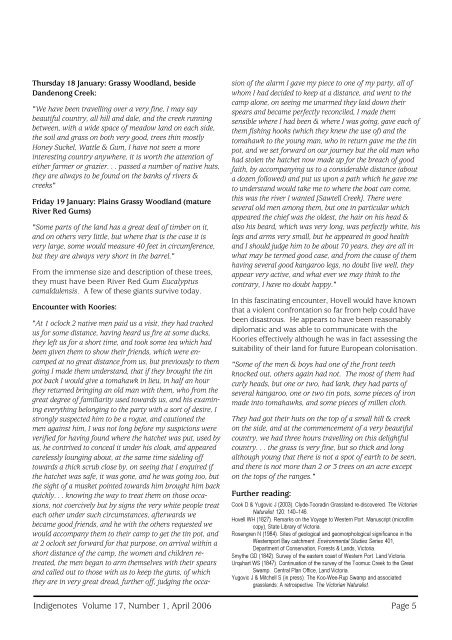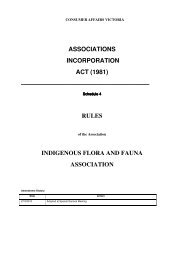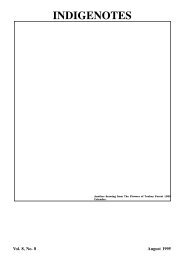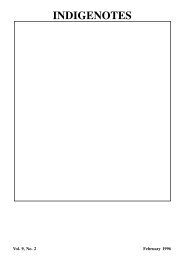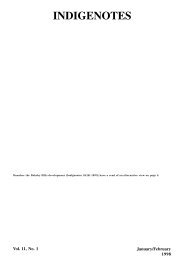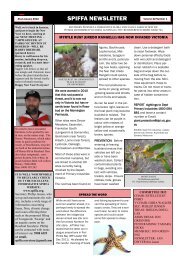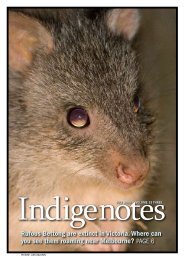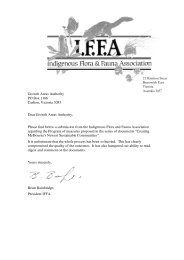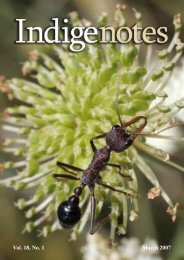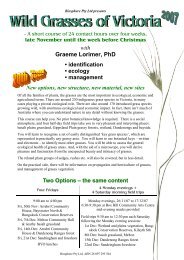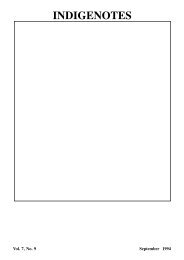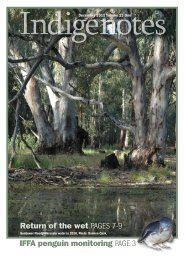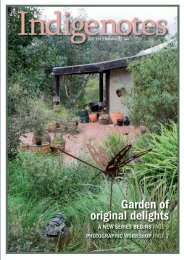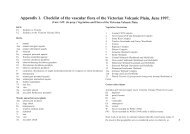Vol. 17, No. 2 September 2006 - Indigenous Flora and Fauna ...
Vol. 17, No. 2 September 2006 - Indigenous Flora and Fauna ...
Vol. 17, No. 2 September 2006 - Indigenous Flora and Fauna ...
You also want an ePaper? Increase the reach of your titles
YUMPU automatically turns print PDFs into web optimized ePapers that Google loves.
Thursday 18 January: Grassy Woodl<strong>and</strong>, beside<br />
D<strong>and</strong>enong Creek:<br />
"We have been travelling over a very fine, I may say<br />
beautiful country, all hill <strong>and</strong> dale, <strong>and</strong> the creek running<br />
between, with a wide space of meadow l<strong>and</strong> on each side,<br />
the soil <strong>and</strong> grass on both very good, trees thin mostly<br />
Honey Suckel, Wattle & Gum, I have not seen a more<br />
interesting country anywhere, it is worth the attention of<br />
either farmer or grazier. . . passed a number of native huts,<br />
they are always to be found on the banks of rivers &<br />
creeks"<br />
Friday 19 January: Plains Grassy Woodl<strong>and</strong> (mature<br />
River Red Gums)<br />
"Some parts of the l<strong>and</strong> has a great deal of timber on it,<br />
<strong>and</strong> on others very little, but where that is the case it is<br />
very large, some would measure 40 feet in circumference,<br />
but they are always very short in the barrel."<br />
From the immense size <strong>and</strong> description of these trees,<br />
they must have been River Red Gum Eucalyptus<br />
camaldulensis. A few of these giants survive today.<br />
Encounter with Koories:<br />
Indigenotes <strong>Vol</strong>ume <strong>17</strong>, Number 1, April <strong>2006</strong><br />
"At 1 oclock 2 native men paid us a visit, they had tracked<br />
us for some distance, having heard us fire at some ducks,<br />
they left us for a short time, <strong>and</strong> took some tea which had<br />
been given them to show their friends, which were encamped<br />
at no great distance from us, but previously to them<br />
going I made them underst<strong>and</strong>, that if they brought the tin<br />
pot back I would give a tomahawk in lieu, in half an hour<br />
they returned bringing an old man with them, who from the<br />
great degree of familiarity used towards us, <strong>and</strong> his examining<br />
everything belonging to the party with a sort of desire, I<br />
strongly suspected him to be a rogue, <strong>and</strong> cautioned the<br />
men against him, I was not long before my suspicions were<br />
verified for having found where the hatchet was put, used by<br />
us, he contrived to conceal it under his cloak, <strong>and</strong> appeared<br />
carelessly lounging about, at the same time sideling off<br />
towards a thick scrub close by, on seeing that I enquired if<br />
the hatchet was safe, it was gone, <strong>and</strong> he was going too, but<br />
the sight of a musket pointed towards him brought him back<br />
quickly. . . knowing the way to treat them on those occasions,<br />
not coercively but by signs the very white people treat<br />
each other under such circumstances, afterwards we<br />
became good friends, <strong>and</strong> he with the others requested we<br />
would accompany them to their camp to get the tin pot, <strong>and</strong><br />
at 2 oclock set forward for that purpose, on arrival within a<br />
short distance of the camp, the women <strong>and</strong> children retreated,<br />
the men began to arm themselves with their spears<br />
<strong>and</strong> called out to those with us to keep the guns, of which<br />
they are in very great dread, further off, judging the occasion<br />
of the alarm I gave my piece to one of my party, all of<br />
whom I had decided to keep at a distance, <strong>and</strong> went to the<br />
camp alone, on seeing me unarmed they laid down their<br />
spears <strong>and</strong> became perfectly reconciled, I made them<br />
sensible where I had been & where I was going, gave each of<br />
them fishing hooks (which they knew the use of) <strong>and</strong> the<br />
tomahawk to the young man, who in return gave me the tin<br />
pot, <strong>and</strong> we set forward on our journey but the old man who<br />
had stolen the hatchet now made up for the breach of good<br />
faith, by accompanying us to a considerable distance (about<br />
a dozen followed) <strong>and</strong> put us upon a path which he gave me<br />
to underst<strong>and</strong> would take me to where the boat can come,<br />
this was the river I wanted [Sawtell Creek]. There were<br />
several old men among them, but one in particular which<br />
appeared the chief was the oldest, the hair on his head &<br />
also his beard, which was very long, was perfectly white, his<br />
legs <strong>and</strong> arms very small, but he appeared in good health<br />
<strong>and</strong> I should judge him to be about 70 years, they are all in<br />
what may be termed good case, <strong>and</strong> from the cause of them<br />
having several good kangaroo legs, no doubt live well, they<br />
appear very active, <strong>and</strong> what ever we may think to the<br />
contrary, I have no doubt happy."<br />
In this fascinating encounter, Hovell would have known<br />
that a violent confrontation so far from help could have<br />
been disastrous. He appears to have been reasonably<br />
diplomatic <strong>and</strong> was able to communicate with the<br />
Koories effectively although he was in fact assessing the<br />
suitability of their l<strong>and</strong> for future European colonisation.<br />
"Some of the men & boys had one of the front teeth<br />
knocked out, others again had not. The most of them had<br />
curly heads, but one or two, had lank, they had parts of<br />
several kangaroo, one or two tin pots, some pieces of iron<br />
made into tomahawks, <strong>and</strong> some pieces of millen cloth.<br />
They had got their huts on the top of a small hill & creek<br />
on the side, <strong>and</strong> at the commencement of a very beautiful<br />
country, we had three hours travelling on this delightful<br />
country. . . the grass is very fine, but so thick <strong>and</strong> long<br />
although young that there is not a spot of earth to be seen,<br />
<strong>and</strong> there is not more than 2 or 3 trees on an acre except<br />
on the tops of the ranges."<br />
Further reading:<br />
Cook D & Yugovic J (2003). Clyde-Tooradin Grassl<strong>and</strong> re-discovered. The Victorian<br />
Naturalist 120: 140–146.<br />
Hovell WH (1827). Remarks on the Voyage to Western Port. Manuscript (microfilm<br />
copy), State Library of Victoria.<br />
Rosengren N (1984). Sites of geological <strong>and</strong> geomorphological significance in the<br />
Westernport Bay catchment. Environmental Studies Series 401,<br />
Department of Conservation, Forests & L<strong>and</strong>s, Victoria.<br />
Smythe GD (1842). Survey of the eastern coast of Western Port. L<strong>and</strong> Victoria.<br />
Urquhart WS (1847). Continuation of the survey of the Toomuc Creek to the Great<br />
Swamp. Central Plan Office, L<strong>and</strong> Victoria.<br />
Yugovic J & Mitchell S (in press). The Koo-Wee-Rup Swamp <strong>and</strong> associated<br />
grassl<strong>and</strong>s: A retrospective. The Victorian Naturalist.<br />
Page 5


